The 10-in-1
Ration
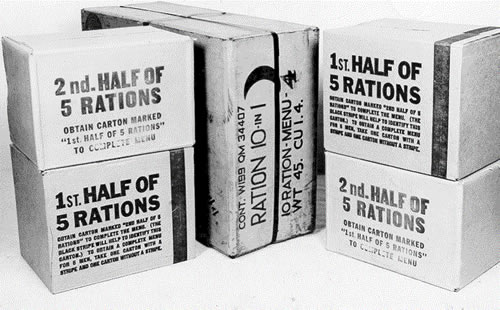
The
Ration, 10-in-1 was designed to feed groups of men, primarily AFV
crews or motorized infantry in armored units. Inspired by the success
of British 14-in-1 "compo" rations and a previous American
5-in-1 package, the 10-in-1 ration offered one day of meals —
breakfast, evening supper, and a midday "snack" —
for 10 soldiers. The 10-in-1 was introduced in mid-1943 and over
300 million rations were produced by the end of the war.
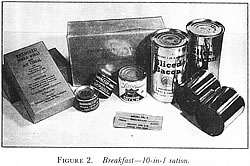 The
food for breakfast and supper were packed together for group cooking
at the beginning and end of the day, and were similar to the offerings
in the K-rations: various canned meats and stews, butter spread,
powdered coffee, pudding, jam, evaporated milk, vegetables, biscuits,
cereal, beverages, candy, salt, and sugar, as well as the typical
accessories of cigarettes, matches, can opener, toilet paper, soap,
towels, etc. The
food for breakfast and supper were packed together for group cooking
at the beginning and end of the day, and were similar to the offerings
in the K-rations: various canned meats and stews, butter spread,
powdered coffee, pudding, jam, evaporated milk, vegetables, biscuits,
cereal, beverages, candy, salt, and sugar, as well as the typical
accessories of cigarettes, matches, can opener, toilet paper, soap,
towels, etc.
The
dinner was more of a snack, with only biscuits, candy, sugar, and
gum, and was separately packaged (small tin cans in boxes as below
left) so it could be easily handed out to soldiers who were on the
move during the day.
Surprisingly,
for an institutional behemoth where anything that didn't move of
it's own accord was painted olive drab, there was a surprising tolerance
for other colors in rations packaging. By and large, most cans were
finished in a gold laquer with black markings. But as you can see
in these photos, U.S. food manufacturers sometimes affixed their
labels to the cans, perhaps encouraged to provide a reminder of
home and what our service men and women were fighting for —
liberty and Bloomer Green Beans!
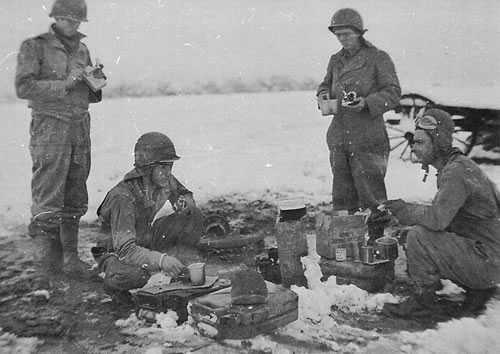
10-in-1 Packaging
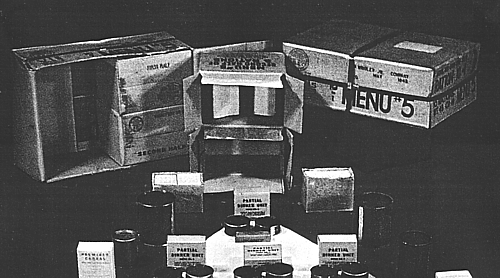
Though
bulkier in packaging and weighing nearly 50 lbs., the 10-in-1 offered
more variety to soldiers. Leg infantry often envied this greater
assortment and would barter for these meals with the armored units
attached to their divisions.
Again,
the military dictated a progressive series of packages to ensure
ensure quality. The full day's rations were divided into two pair
of cartons, each pair containing food for five men. The four assembled
cartons were then placed into the larger carton that is familiar
to modelers.
According
to C.Q.D. No. 140B, dated August 1, 1944, two of these cartons contained
inner waxed cartons that held more moisture-sensitive items. These
inner cartons were made of cardboard 0.042 (approximatley 3/16)
inch thick, with inner dimensions of 9 5/8" x 6 3/8" x
7 1/8". The flaps were secured with water-resistant adhesive
and double-dipped in wax for waterproofing.
The
corrugated box that contained the waxed carton "shall be labeled
on both the 7 5/16 by 9 13/16 inch panels as follows:
MENU
# ___ (1 inch capital letters - bold type)
FIRST HALF OF
5 RATIONS
FOR
5 COMPLETE RATIONS (1/4 inch capital letters - bold type)
USE THIS BOX AND ONE MARKED
"SECOND HALF OF 5 RATIONS"
One
top and one bottom outer flap shall be labeled as follows:
FIRST
HALF
The
unwaxed cartons of 0.075 inch thick fiberboard held canned food,
soap, towels and sponge. Because they were not waxed, they were
labeled as follows:
MENU
# ___ (1 inch capital letters - bold type)
SECOND HALF OF
5 RATIONS
FOR
5 COMPLETE RATIONS (1/4 inch capital letters - bold type)
USE THIS BOX AND ONE MARKED
"FIRST HALF OF 5 RATIONS"
One
top and one bottom outer flap shall be labeled as follows:
SECOND
HALF
Finally,
the four boxes were assembled into the larger carton, which had
inside dimensions of 20 5/16 inched in length, 14 1/8 inches in
width, by 7 7/8 inches in depth. This was likely the V1 or V2 corrugated
cardboard, which was the strongest type available and typically
3/16" thick. After the flaps were glued, the carton was slid
into a sleeve that "shall fit snugly over the top, bottom,
and ends of the container without requiring undue pressure to place
into position. The depth of the sleeve shall be equal to the full
outside width of the shipping container."
The
carton and sleeve was secured with three straps 3/8" wide and
0.015 inch thick. "One strap shall be centered over the ends
and sides of the case, and the second strap centered over the top,
bottoms, and sides of the case in such a manner that they cross
at right angles over the open end of the sleeve. The longer strap
shall be applied first.
The
case and outer sleeve shall be printed in bold Gothic capital
letters as follows:
On
one end of the sleeve:
CONT
____ (Contract No.) (1/2 inch letters)
RATION 10-IN-1 (1 1/2 inch letters)
(1 inch space for strap)
10 RATIONS (3/4 inch letters)
WT 49 CU 1.5 MENU # ___ (2 inch letters)
On
the other end of the sleeve: As above, omitting the contract number.
The above marking may occupy the entire ends of the sleeve.
On
the right-hand side of the front of the case, the following information
shall be printed:
___________
(Name of Packer) (1/2 inch letters)
____ ____ (Month and Year Packed) (1/2 inch letters)
REQ. ____ (Requisition number, required on some cases)
(1/2 inch letters)
(1 inch space for strap)
10
in MENU # ___
1
The
marking "10-in-1" shall be in letters 3/4 of an inch
high. The lines forming the letters MENU and the numeral shall
be 3/8 of an inch in width, and the letters and numerals 2 1/2
inches high."
The
crescent was to be 3 inches tall by 2 inches wide, with the center
of the crescent 7/8 inches in width.
The
reproduction below from the Strictly GI re-enactors does a good
job capturing the labeling as specified above. And if you compare
these specs to the photo at the top of the page, you'll see there
was some variations in the markings over the the years (the specs
don't say anything about the stripe and instructions to take one
carton with a stripe and one without to make up a complete menu.)
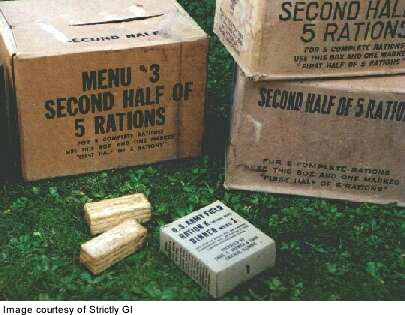
1/35 Scale
10-in-1 Rations
| |
|
|
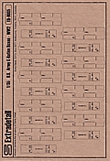 |
|
| Product |
Custom
Dioramics (CD5001) U.S. Army Field C-Rations WWII |
DIOART
(050) WWII U.S. Army (1944-45) Menu 1 & Menu 2 |
Extra
Detail (ED-0005) U.S. Army C-Rations Boxes WW2 |
Hudson
& Allen Studio (1110):
C-Rations Set 1: U.S. Army - World War II
|
Number
of Items |
6
large and 6 small cartons. |
12
each of menu 1 and 2 half-component boxes. |
9
fiberboard cartons with sleeves. |
11
fiberboard cartons with sleeves.
|
| Historical
dimensions |
20
1/2 x 14 5/16 x 8 1/16 |
9 13/16 x 7 5/16 x 6 9/16 |
20
1/2 x 14 5/16 x 8 1/16 |
20
1/2 x 14 5/16 x 8 1/16 |
| Product
dimensions |
Large:
20 1/2 x 20 1/2 x 10
Small:
20
x 14 x 8
|
15
1/2 x 10 x 9 1/2 |
Carton:
21 x 14 1/2 x 7
Sleeve:
22 x 14 x 7 1/2 |
Carton:
20
1/2 x 13 3/4 x 7
Sleeve:
22 x 14 1/2 x 8 1/4
|
|
Material
and
color
|
Light
card stock, grey printing over-printing |
Paper;
tan. |
Light
card stock, more brown in color. |
Light
card stock; color is acceptable. |
| Instructions |
No |
No |
No |
Yes |
| Markings |
(large
carton, Vietnam era)
RATION 10
10 RATIONS
MENU 2
(small
carton)
US ARMY NO. 135-C45
RATIONS 10-
10 RATIONS
WT45 CU14 MENU 4
DON'T EXPOSE TO EXTREME TEMPERATURES
|
MENU
#1
FIRST HALF OF
5 RATIONS
MENU
#2
SECOND HALF OF
5 RATIONS
and fine print.
|
RATION
10-1
10 RATIONS
WT45 CU14
MENU 3 (or MENU 4)
fine print and stampings; markings are on four sides of sleeve,
three sides of carton. |
RATION
10-1
10 RATIONS
WT45 CU14
MENU 5 (or MENU 4)
fine print and stampings; markings are on four sides of sleeve,
two sides of carton. |
| Comments |
This
product, from the VLS family, is virtually identical to Verlinden's,
warts and all. Since the designer of the CD product, Willy
Peeters, previusly worked for Verlinden, that may explain
the distinct similarity. However, the CD cartons leave off
bits of the markings, perhaps to escape some sort of "copyright"
infringement between the two warring organizations. Not that
U.S. military markings are copyrighted, but perhaps erroneous
facsimiles could be.
CD
takes Verlinden's errors one step further by claiming the
large square-shaped carton is from WWII, which it is not.
Otherwise,
the box assembly design is identical, as is the over-printing
of screened ink to "color" the cartons. No sleeves
are provided.
|
Carton
dimensions are significantly out of scale. Outlines are printed
in light grey so the corners do not need to be scuffed.
The
photo below is of an older version of this product. The new
version is printed on tan paper, so the inside of the carton
is the same color as the outside.
|
There
are a few folding guides that are printed very lightly. This
somewhat hinders construction, but there is less to have to
scuff off.
Flaps
do not extend to meet one another, leaving gaps that reveal
empty cavity inside carton.
Outer
sleeve is undersized so it does not fit around carton without
distorting one piece or the other.
Printing
is not as crisp as Hudson & Allen products.
|
Excellent
appearance and easy construction. Make sure you have the correct
sleeve and carton for each of the two menus. |
|
Finished
Product
|
|
|
|
|
| Final Thoughts |
Since
this product adds nothing new to the market other than additional
errors, I'm not sure its true purpose isn't to poke a thumb
in the eye of a former partner. Avoid it. |
The
only product of its kind, could use improvement in size. |
Disappointing
fit of sleeves and carton flaps; Hudson & Allen products
are considerably better. |
Very
good. Dimensions are off a touch, but markings are sharp and
quite acceptable. Best of its kind. |
|
|
|
|
| Product |
Tamiya
(35122) M4A3 Sherman includes boxes and decals |
Tamiya
(66665) Combat Rations A |
Verlinden
Productions (16) U.S. Army Field C-Rations
|
|
Number
of Items
|
2
wooden boxes |
9
fiberboard rations cartons and 4 cartons of tomato juice. |
7
large and 6 small cartons.
|
10-in-1
Historical dimensions |
No
evidence wooden boxes were used for 10-in-1 rations. |
20
1/2 x 14 5/16 x 8 1/16 |
20
1/2 x 14 5/16 x 8 1/16 |
| Product
dimensions |
24
x 17 x 10 |
19
x 12 x 6 |
Large:
20 1/2 x 20 1/2 x 10
Small:
20 1/2 x 14 x 8
|
Material
and color |
Styrene
and decal; must paint unfinished wood color. |
Light
card stock; instructions are printed on back, making it difficult
to show cartons opened. |
Medium
card stock, more pinkish color; boxes are screenprinted for
darker shading than stock. Finished product is not as "tight"
as lighter card stocks. |
| Instructions |
Yes |
Yes |
No |
| Markings |
RATION
10 IN 1
10 RATIONS
WT45 CU14 MENU 2 (or MENU 4)
|
10
IN 1, MENU 5
small print and various stampings. |
(large
carton, Vietnam era)
RATION 10
10 RATIONS
WT45 CU14 MENU 2
(small
carton)
RATIONS 10-1
10 RATIONS
WT45 CU14 MENU 4
DON'T EXPOSE TO EXTREME TEMPERATURES
|
| Comments |
First
of all, I could not find any information that wooden boxes
were used for 10-in-1 rations.
Boxes are one piece with hollow bottom. Only top lid has "wood
grain" and two exposed support cross pieces — which
makes one wonder what braced the bottom slats.
In
Tamiya's later M4A3 Sherman kits (#35250 and #35251), these
are no longer rations boxes but now "stowage boxes"
and new, better-sized K ration boxes are included.
Decals
are a little thick; Spray the painted boxes with gloss varnish
and use some Solvaset to get them to snug down tight. Weather
slightly and cover with a matte varnish.
|
Easy
to assemble. But unlike the other products, carton only has
printing on one side, but that one side looks "official"
and conforms well to the image at the top of the 10-in-1 Packaging
section of this article. No sleeves are provided.
Product
name "Rations A" is puzzling, as there were no Rations
A during WWII!
Product
includes 4 cartons of Quartermaster tomato juice.
|
This
set is the granddaddy of all rations cartons (I made the examples
below years ago, adding black electrical tape for the metal
strap). But they've been surpassed by better options. The
smaller carton has some bogus markings. The end closure is
two flaps that meet in the center, rather than one panel that
secures the end. Consequently, the metal band around the side
circumference would not ensure the closure of the two flaps
and the integrity of the packaging. No sleeves are provided.
The
larger, square-shaped carton is from the Vietnam era. Unfortunately,
since the product doesn't make this clear, a lot of WWII modelers
have used the wrong rations boxes!
|
Finished
Product |
|
|
|
| Final Thoughts |
Forget
the decals. Use these as stowage or ammo boxes. |
Fair.
Product is quite undersized. Use them where the one printed
side will be visible, such as stacked in a GMC Cargo Truck. |
Much
better products are available. |
|












